
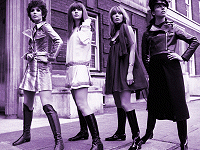

|
 |
|
| Although
there is a tendency to think of the Sixties as a whole decade in terms of
fashion it can, in fact, be viewed as two separate and quite distinct parts,
with the early years clinging on doggedly to modifications of Fifties styles
and the later years exploding into the wild fashion frenzy for which the
decade is possibly best remembered. The highly revealing and unprecedented 'mini' fashions that shocked society first started appearing in quantity during 1965 when British designers such as Ossie Clark, Bill Gibb and Mary Quant, along with 'fashion boutiques', the King's Road and Carnaby Street, ruled the fashion world, even though the 'Paris fashions' of Saint Laurent, Courreges and Ungaro were still iconic fashion names. These mini dresses and the 'A-line' fashions provided a perfect vehicle for the colourful psychedelic and dramatic black and white Op and Pop-art pattern designers and artists. Fashions for men also displayed far greater imagination, incorporating patterns and bright colours with fitted styling. Among young males, 'quiff' hairdos were still around, but were fast being replaced by Beatle-style 'mop tops'. Drainpipe trousers survived quite happily for a while, with 'winkle picker' shoes and slim 'college' ties. New synthetic fabrics were increasingly widely used, including nylon for shirts and blouses, crimplene for coats and jackets and shiny PVC for footwear, rainwear and decorative trim effects. Crotchet and knitwear also enjoyed a revival, most particularly in the manufacture of mini-dresses, hats and women's jumpers. The post-war 'Baby Boom' meant that there were an unprecedented number of teenagers at the start of the 60s and, with unemployment virtually non-existent compared to today, they had plenty of money. The items on which they chose to spend it were pop music and clothes, to an extent previously undreamed of. Teddy Boys had established a teenage market in the Fifties and made it acceptable for males to dress for show. Now both sexes became increasingly fashion-conscious and the trend-makers made the most of it.The biggest fashion change from the Fifties came with the rise in hemlines. |
| Mary
Quant, who opened her first Bazaar boutique in Chelsea's Kings Road in 1955
with partner Archie McNair and future husband Alexander Plunket-Greene (after
whom the restaurant underneath it, called Alexander's, was named), followed
by a second in Knightsbridge in 1961, is generally accepted to be the instigator
of the mini-skirt fashion although its exact roots are unknown. Her ingenue
smock dresses were also influential in the early Sixties. The boutique, although the idea had been around since the 1920s as a way of selling the by-products of haute couture, was seen as an innovation in shopping habits and was, as she said herself, '... a kind of permanently running cocktail party ' By 1963 Mary had formed the 'Ginger Group' which was exporting its own mass-produced designs to the U.S.A. and she also launched her own cosmetics range in 1966 and footwear collection in 1967. Shopping for clothes had become fun, a fact quickly picked up on by many others. Yves Saint Laurent, who had become the house designer for Christian Dior when Dior died in 1957, started his own fashion house and also opened up a chain of 160 boutiques called 'Rive Gauche', but not until 1966. Although not an innovative designer, he is important because he was the first couturier to develop ready-to-wear clothes on a large scale. In 1963 hemlines were just above the knee but the rise gained extra momentum and popularity when designs by Andre Courreges appeared in Vogue in 1964. By the end of 1965 skirts six inches above the knee were not uncommon and some venues barred them from being worn. Coco Chanel described the mini skirt as 'the most absurd weapon woman has ever employed to seduce men' and promoted its more 'staid' opposition, the trouser suit. |
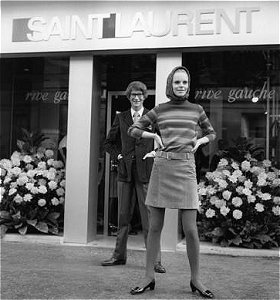 |
The changing fashion scene did not go unnoticed by the Treasury. In 1965
we spent almost £1.7billion on clothing - on a £10 to £15
weekly wage! Up until 1966 skirts under 24" long were classed as 'children's
clothing'. In
fact, the dresses were becoming so small that on 5th November 1965 the government
brought in new Customs and Excise rules to prevent women avoiding taxes
by buying children's sizes. The 10% tax depended on the length of the clothes
..... before a rethink! From
1st January 1966, women's clothes were assessed for tax purposes according
to bust size, not length. The Kings Road in Chelsea became one of the main clothes centres of Sixties London, following the success of a small lane behind Regent Street near Oxford Circus, called Carnaby Street. These were the fashion shrines of British youth in the early to mid Sixties. By 1965 Carnaby Street had become the mecca for boutiques, with all the latest clothes for the dedicated fashion followers of 'Swinging London'. An article in the New York Times in May 1966 described Britain (i.e. London's King's Road to Soho area) as 'the new Sodom and Gomorrah'. The most influential retailer there, having great success in getting men to follow fashion as much as women did, was John Stephen, a grocer's son from Glasgow. He acquired his first boutique in 1963 and ended up owning ten shops in Carnaby Street with names like 'Male West One', 'Mod Male' and 'His Clothes'. He also owned a similar number around other areas of the capital as well as at least two in Brighton. Although John's name is inextricably entwined with the gimmickry and 'fad' perception of 'Carnaby Street' fashion, he also had a very good understanding of other aspects of the business, including updates on classic styles of ready-made suits. For example, in 1968 he was advertising 'Mohair, cashmere, wool and worsted jackets and suits…cut with the flair of John Stephen designs - but gently'. Other Carnaby Street establishments included 'Lord John' owned by Warren and David Gold and 'Lady Jane' owned by Harry Fox. In 1967 there were more than 2000 'boutiques' registered for business in the Greater London area. Graphic map of the Carnaby Street shops and boutiques in the Sixties Graphic map of the Kings Road shops and boutiques in the Sixties See my Soho and Carnaby Street pages for a far more detailed description of its history, coffee bars, clubs, boutiques and the establishments of Sixties Carnaby Street. |
| Away
from Carnaby Street another leading London fashion name was Barbara Hulanicki
who started BIBA as a mail-order operation
in 1964 with her ad-man husband Stephen Fitzsimon. They
felt that the price of designer goods was far too high for most people and
adopted and promoted the 'use for a while, throw away and buy more' marketing
philosophy. Barbara
designed her own fabrics, generally using combinations of 'art deco' and
'art nouveau'. The business really took off when the Daily Mirror featured
one of their gingham dresses at under £3 and orders started to pour in.
Hulanicki's ultra modern, affordable and attractive styles made her a cult figure in the fashion business leading, in 1963, to her opening the BIBA boutique in Abingdon Road. Dark wood screens, low lighting and pop music gave the place the air of a discotheque and potential customers were actively encouraged to go inside and try whatever they liked. The largest store was opened in Kensington High Street in 1969 (right), which had an all-black 1930s style décor with twenty or more potted palms and even more hat stands. Selling BIBA clothes, BIBA make-up, BIBA everything! it survived until 1973 when it moved to the old Derry & Toms store in Kensington, finally closing it's doors in the mid-seventies. Terence Conran had set up his own furniture-making business in 1952, which started in a basement studio in London's Notting Hill. In 1956 The Conran Design Group was founded, initially as part of the furniture-making business. Fast becoming a leader in raising design awareness, he opened his first 'Habitat' store at 77 Fulham Road in May 1964, concentrating on modern furniture and home accessories. Conran provided innovation and good design at affordable prices, much of it imported from Europe. Habitat soon introduced Swinging London to a range of French cookware, displayed in a simple, austere environ of white-painted walls and quarry tiled flooring. Fashion-conscious Londoners flocked to his first shop, with customers such as John Lennon, Mary Quant, George Harrison and Julie Christie all buying their furniture there. The staff's uniforms were designed by Mary Quant herself. |
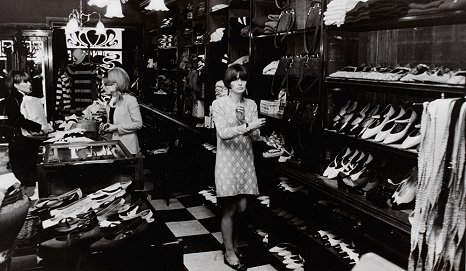 |
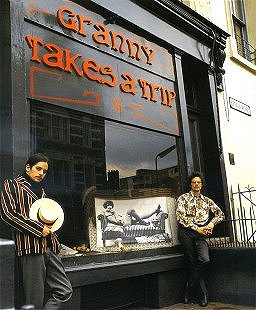 |
John Pearse, Sheila
Cohen and Nigel Waymouth offered a very different view of fashion when they
opened 'Granny Takes a Trip' at the World's End in 1965. Behind a very surreal
series of temporary shop frontages they promoted a mysterious and unique
'look' based on nostalgic and psychedelic concepts - a sort of grown-ups
'dressing-up box'. In 1966, the discovery of rolls of unused snakeskin in
a warehouse, purely by chance, inspired Ossie Clark to develop a look that
sculpted and accentuated rather than concealed the torso. He formed the
skins into fitted jackets, based on black leather 'biker' jackets, to be
worn with culottes and midi or maxi skirts. Shirt collars became wider, rounded and button-down. Suit lapels also became wider and 'kipper' ties abounded in ever more startling combinations of colour and design, combining the neat look of the mods with the expressive, bright colours of hippie flower-power psychedelia which reached its peak in 1967, flooding the 'alternative' fashion world with kaftans, afghan coats, beads, body paint and flowers in the hair. This year, above all others, was probably the peak in variety and diversity of cultures and fashions. It was generally a matter of the opinion of your own personal 'group' whether something was actually 'in' or not. Quite apart from being 'The Summer Of Love', 1967 was also the 'Year Of The Turtle' according to fashion paper The Daily News Record. Turtle in this case being the turtle-neck sweater which doubled both as an acceptable alternative to a collar and tie with a suit or a completely informal top with almost anything else. The garment had been around since the 20's, being a favourite of Noel Coward, but re-emerged in the Sixties both as a Beatnik favourite and, later, celebrity fashion as popularised by such as Bobby Kennedy, Paul Newman, Steve McQueen and James Coburn, among others. Other more or less popular 'fads' of the Sixties included false fingernails, false eyelashes ( male mods often used eye makeup or mascara to enhance their looks ) and, for some reason, disposable paper knickers. 'Disposable' clothing really reached its zenith around 1966 - 68 (estimated sales in the US in 1967 were between 50 and 100million dollars!) but was generally more of a gimmick than a viable alternative. Society was adopting an increasingly 'throw-away' attitude and disposable cutlery, nappies and cigarette lighters were already commonplace. Throw-away clothes, furniture etc. were the next logical step. Even NASA had considered producing paper clothing for future space-travellers. The Scott Paper Company pre-empted them when, in a 1966 publicity stunt, they released their psychedelic paisley shift, a dress that cost $1.25. It originally came in two designs, a black and white Op Art motif and a red bandanna pattern. Scott advertisers described the paper dress as "created to make you the conversation piece at parties. Smashingly different at dances or perfectly packaged at picnics. Wear it anytime...anywhere. Won't last forever...who cares? Wear it for kicks -- then give it the air." They sold over half a million in the U.S.A. in six months! When paper clothing hit the UK's shores in 1967, even the Beatles got in on the fad and wore paper jackets in public. However, disposable clothes were not really much cheaper to make than ordinary dress production. |
| The 'celebrity
boutique' concept was probably started by the mod RSG! presenter Cathy McGowan
who originally wore BIBA clothes on the show but had her own range of boutique
clothes by 1965. Pop singer Sandie Shaw opened her own boutique at 68 Wells
Street, just off Oxford Street, in September 1967 which lasted until she
married fashion designer Jeff banks (it is now Voltage TV but the round
window is still there). Model Twiggy and singer Lulu were also heavily associated with clothes (and cosmetics) design and promotion, including their own 'fashion labels'. These were essentially marketing exercises for both the artist and whichever clothes manufacturer/designer was producing for them, although they did design some clothing themselves. Sandie later went on to run an up-market second hand clothes boutique. Lulu became the 'face' of Freeman's catalogue in the 1970s as the brand tried to incorporate a boutique atmosphere into their catalogue. In Manchester, United footballer George Best opened his somewhat infamous boutique, 'Edwardia', at 55-57 Bridge Street in October 1967 in partnership with City footballer Mike Summerbee. The event was attended by around 400 fans (mainly schoolgirls!) and the shop window almost gave way under the pressure of bodies. |
| The first
'traditional' store to attempt to cater specifically for the youth market
was Woollands who opened the '21 Shop' as an in-store boutique for young
working women in 1961. Their clothes were 'simple, zany, not for squares'.
The head buyer, 22-year-old Vanessa Denza, worked closely with young designers at the Royal College of Art who showed talent and it was not unknown for an order of 1000 dresses to be delivered within a week and sold by the following week. Other large retailers soon copied this idea and 'Young Jaeger', 'Miss Selfridge' and Harrods 'Way In' became very popular. Another trendy place to shop was Cecil Gee in Shaftesbury Avenue. Fashion boutiques with bright lights, colours and pop music opened with enthusiasm all over the country. Of course, to display the clothes to their best effect, fashion models were required and the big names in fashion modelling were Jean 'The Shrimp' Shrimpton and Lesley 'Twiggy' Hornby, known as The Face and The Image of the Sixties respectively. Other top Sixties models were Patti Boyd who married Beatle George Harrison, Penelope Tree, Paulene Stone, the incredibly tall Veruschka and willowy Peggy Moffitt. In 1964 the World In Action programme produced by Granada Television made an edition called 'The Face On The Cover' in which a TV crew followed Jean Shrimpton on modelling assignments in New York and London. |
|
At the age of 15, Twiggy
was already dating one of the top hairdressers, Justin de Villeneuve. Woman's
Mirror magazine had been searching for models who were young and exceptionally
thin, and found their ideal match in Lesley Hornby. Twiggy was only six
and a half stone and a size 6. Villeneuve arranged a modelling photo session
for her, the results of which led to her being featured in all the leading
fashion magazines and attaining celebrity status virtually overnight. With
her boyish looks and 31-22-32 figure she was commanding fees of £80
an hour at a time when the average wage was £15 a week. She further influenced the fashion scene by bringing out her own range of clothes in 1967. Between them, Twiggy and The Shrimp changed the general public's concept of fashion models, and fashion itself, completely. Driven by the need for constant change in fashions the mini skirt soon became a mini dress which, combined with the 'A' line design which hung straight onto the hips, ignored the fact that girls had a waist at all. This 'waist-less' look soon became apparent in the design of trousers as well, which became much lower-cut, sitting on the hips instead of the waist, hence their name - 'hipsters'. Stretch trousers made from wool and helanca or Bri-nylon were also still an extremely popular commercial style. To emphasise the slim line they were made with stirrup loops to fit around the feet and stretch the fabric straight down from the seat rather than clinging to the hips and thighs. Slimma, the well-known British ladies' trouser makers, sold them in large quantities for years, although the style had been around since the late fifties. The trouser suit for women, born in the previous decade but popularised by designers in the early 60s, was still highly controversial and was frowned upon by the upper classes, being perceived as 'poor woman's dress'. Some establishments refused entry to anyone wearing them - an attitude which changed somewhat in 1963 when the style 'took off' almost overnight after 'Ready Steady Go's Cathy McGowan wore them on the TV pop show. Prior to 1962, sleeves were either 'long' or 'short'..... then someone came up with the idea of a three-quarter length sleeve which ended halfway down the forearm. There was no real fashion basis for the style, just the fact that it hadn't been done before, therefore it was an instant, massive hit. Hemlines continued to rise and, by 1968, had become what was not much more than a very wide belt - the 'micro' skirt - so it seemed the only way to go was down. The straight midi skirt, calf length, took over in 1969 soon followed by the ankle length maxi. This design change also affected the length of coats and it was not unusual to see mini or micro skirts being worn under an open, ankle length coat. The advent of the rising hemline heralded the end for traditional stockings and suspenders which were virtually obsolete by 1965. They were replaced by the new, seamless, one-piece 'tights' in various colours and patterns. Stockings returned much later, but as self-supporting items which did not need a suspender belt. |
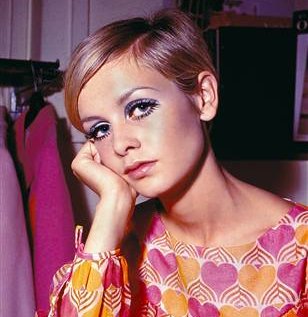
|
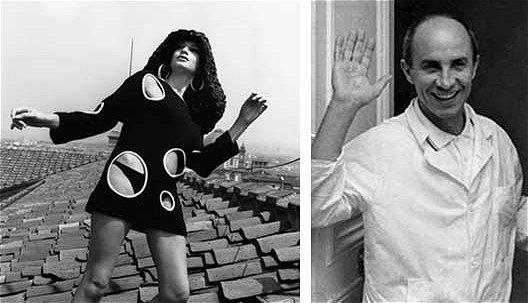 |
New
materials were also being produced. Crimplene and Trevira arrived in 1961
and happily joined the other synthetics such as Acrilan, Bri-nylon, Orlon,
vinyl and PVC which provided a whole new design medium for fashion garments.
Imitation leather and suede was widely used for shorter length 'car coat'
styles, often with woollen collars and cuffs. A
popular leather substitute was 'Corfam', made by DuPont, used by Rayne to
make court shoes and also by Mary Quant for ankle boots. Synthetics also provided the basis for the shiny, sometimes collar-less 'Beatle-style', wet look two-tone suits favoured by the mods of the early Sixties. As the decade progressed, styles converged towards a unisex look, hipsters and 'T' shirts being the most common denominator. The first 'topless' dress designs appeared in 1964 at the ever more outrageous fashion shows but were unsuitable for general public wear as the proud owners soon found themselves on indecency charges. The idea, though, soon translated itself into baring other, less taboo, parts of the anatomy leading to bare midriff designs, Courreges bringing out the 'cut-out' dress with large holes cut in the sides or at the back and front, and the even more adventurous large-stitch crochet and linked-plate creations. Swimwear, predictably, also succumbed to this minimalist trend. The bikini, a more revealing version of the earlier two-piece swimsuit, had been commonly available since 1959, gradually becoming smaller until, in 1964, Rudi Gernreich hit the fashion headlines with his infamous 'topless swimsuit'. He was also responsible for the highly revealing bra-less body stocking fashion of the time. These items exposed breasts for the first time in commercially available fashion and almost instantly became an international controversy. They were allegedly designed as a symbol of women's liberation - as Gernreich himself stated, "...in fashion, as well as every other facet of life." The topless swimsuit soon led to the topless dress, and also gave birth to another revolution, the 'no-bra bra' which effected quite a change to the fit of clothes and was somewhat more acceptable in public. Trouser styles had started the Sixties being about 10" around the leg, the drainpipe fashion preferred by the Teddy boys, but gradually increased in size becoming 'flares' by 1965. Hats, noticeable by their absence as soon as hair styling for men became a fashion consideration, did not become popular again until hairstyles became longer and more casual, and took the form of peaked soft caps in the style worn by Donovan and Dylan. Female trousers went even further into the pantaloon range - almost full-length culottes. |
| At
the lower end of the body, shoe fashions changed almost weekly, ranging
from stiletto heel shoes to thigh length boots, and elastic-sided winklepicker
'Chelsea' boots which were a slim ankle-high boot with a wedge-blocked heel
and an elastic panel on the side, handy for pulling off in a hurry. These
type of boots were inspired by English horse-riding attire, but they achieved
'must have' status in the fashion world when the The Beatles and other top
pop artists were seen wearing them. Cuban heels or the addition of buckles
were also an option.
Other popular footwear included Hush Puppies, Clarks 'desert' boots or Doc Martens, depending on your particular taste and what your 'group' were wearing - bowling shoes were even the height of fashion for a short period! Also popular was the 'Courreges boot', mid calf length with open slots at the top and a tassle or bow in front. These were made of white kid, calf or patent leather. The footwear style known as 'Chelsea boot', originally known as 'paddock boots', has a history that extends as far back as the 1830s when elasticated sides and close-fitting, comparatively lightweight design was popular with the equestrian community. Footwear suppliers Samuel Windsor advise that the style was specifically originated by J. Sparkes-Hall, a boot-maker who supplied them to Queen Victoria. During the 1950s, London's Kings Road 'Chelsea Set' adopted the look as a leisure fashion, inspiring shoemakers Anello & Davide (a dance and theatrical footwear company founded in 1922) to design and introduce a modernised version, in the early Sixties, that they called the 'Baba' boot. Their updated version sported a slim-line look, with a centre seam and the high 'Cuban heel' style that became popular with Mods and Beats. Artist and 'Granny Takes A Trip' boutique owner Nigel Waymouth commented: "We all dressed in that look - pea jackets, very tight jeans and pointed Anello & Davide shoes". Although worn by many top pop personalities, including The Rolling Stones, this style of footwear was probably most significantly popularised by The Beatles. The 'Mersey Beat' website relates that, on their way back to Liverpool from a Paris trip in October 1961, Paul McCartney and John Lennon each bought a pair from Anello's outlet at 96 Charing Cross Road and they very quickly became known as 'Beatle boots' when worn with the collarless stage suits provided by Dougie Millings. |
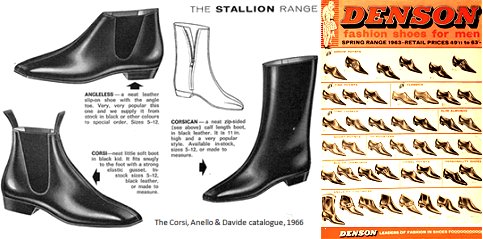 |
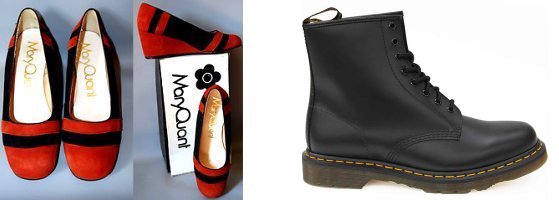 |
Anello
advised that boots made specifically for The Beatles had an 'addition of
a higher Cuban heel from the Flamenco Boot'. They certainly weren't cheap
- the price tag of around £3.15s (£3.75) a pair was quite a lump out of
the average 1961 weekly wage of £15.6s.10d (£15.34). In the mid-1960s Anello
moved from their Charing Cross location to 30-35 Drury Lane, by which time
their range of boots had been considerably expanded to include both sharp
and chiselled-toe styles, with names such as 'Angleless', 'Joka', 'Corsican',
'Apres Ski', 'Embassy' and 'Mexican'. Versions of their style were also
produced by many other contemporary shoemakers, probably the most well-known
of which were D. Senker & Son ('Denson').
'Doc Martens' were invented when the German Dr Maertens injured his foot in a ski-ing accident in Bavaria. He could hardly have foreseen that the orthopaedic-style shoe he designed for himself would become a fashion item, much less the archetypal symbol of rebellion it's descendents were to find themselves. The Grigg family acquired rights to the air cushioned sole in 1958 and started making boots at their Wollaston factory, producing the first boot on the 1st April 1960, hence the style name '1460'. Back in the early Sixties, carry-overs from the late Fifties Beatnik fashion (which also influenced design later in the decade) were sandals for men, flat shoes for women with berets being an early 'must have' fashion item. Even Dior designed a collection of 'beatwear' which included tight black pants and fitted leather jackets.The Edwardian-based fashions of the Teddy Boys (teenaged 'rock and roll' rebels who originated from the more deprived London areas of the early Fifties) which included long slim jackets with velvet trim, thin 'bootlace' ties, short stovepipe trousers revealing brightly patterned socks and suede 'brothel creepers' or 'winkle-pickers' were being adopted in modified styles by the early Sixties 'Mods'. |
| By
1962 tight jeans were a key part of the early Mod scene, popular with both
women and men, and more or less retained until they began being replaced
by the flared, shredded and patched jeans of the Hippie movement. In the latter part of the Sixties, particularly with Hippies, there was a feeling of the need to divest yourself of 'excess baggage' and, for some people, this also included clothing - to be replaced with 'body art', and the use of the skin as a canvas for peace symbols, smiley faces, flowers and all sorts of psychedelic artistic impression. One size fitted all! Not only that, but you could have a new 'wardrobe' every day as long as you had the time (or inclination) to shower. The fad never took off in the full-blown concept (potential arrest and prison presumably having a major influence on this) but body art in various forms was certainly widely used for fashion augmentation and individualisation. Bow ties became a popular unisex accessory, and a revival of 19th Century fashion brought back the 'choker' - a collar of pearls or fabric, gleefully known as the 'dog collar'. Another accessory to 'come back' into fashion in 1964 was the wig, particularly when it was discovered that The Supremes used them on stage. Wigs were also used by men, notably Andy Warhol (who owned more than 500 including silver, blue and white). There were also the famous 'Beatle' wigs (which were one of the best selling pieces of pop-related merchandise ever) although the band themselves made very little from the marketing of them after Brian Epstein failed to recognise the potential. A variety of fashionable 'groovy' wigs were also created and marketed by John Stephen which found considerable popularity with trend-setters. In the latter part of the Sixties the 'afro' wig also enjoyed popularity with both sexes. Films and pop groups also affected the fashion scene. Berets became popular again after Faye Dunaway wore one in 'Bonnie and Clyde', blonde streaks after Audrey Hepburn's appearance in 'Breakfast at Tiffany's' and knee-length vinyl boots and 'space-age' designs after Jane Fonda in 'Barbarella' to name but three from the movie world. Following an appearance by The Beatles at Wembley in 1964 wearing new-look suits designed by Douglas Millings, the style was on sale in John Temple and Neville Reed shops the following October priced at 12 guineas (£12.60). Paul Reeves had been creating unique and limited edition costumes and styles for artists such as Jimmy Page and Jimi Hendrix under the 'Sam Pig In Love' label for a couple of years when, in 1967 with partner Pete Sutch, he purchased a number of Indian bed covers from the now-defunct Kensington department store 'Pettits' and produced some full length kaftans with Nehru collars and half-belts at the back, a couple of which were purchased by George Harrison and Mick Jagger through ' Emmerton & Lambert' in Chelsea Antiques Market. In a shortened version, these were to sell in their thousands and became a major fashion 'craze' of the late Sixties. Reeves launched his company 'Alkasura Wholesale' in 1968. |
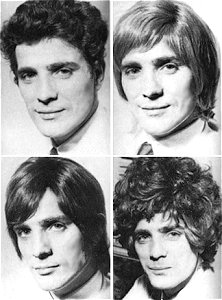 |
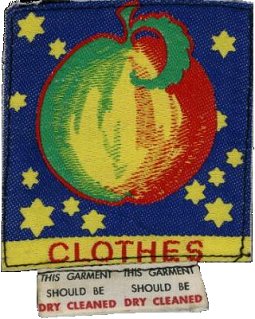
|
In 1968 The
Beatles opened their Apple boutique in the West End, run by Dutch hippie
designers Simon and Marijke, combining the flowery 'hippie' look and 'Sergeant
Pepper' military styles with top designer names.
This was followed on May 22nd by a second shop specialising in theatrical clothing. As a 'by the way', Simon Posthuma and Marijke Kroger were both members of a Dutch band and a pop-art collective called 'The Fool'. Karl Ferris brought them to London from a hippie community on Ibiza in 1966 and, after having some of their work featured in The Times, they opened a studio where they were joined by Barry Finch and Josje Leeger. After getting involved with Epstein's Saville Theatre they were responsible for the external mural and much of the inside design of the Apple boutique. They produced stage clothes for many top bands including The Hollies, Cream, The Move and Procol Harum and were also involved in the design of many LP covers, including some of The Beatles'. Although the establishment was very popular as a showcase for the latest fashions, the high prices tended to make the youth buy their clothes elsewhere and the shops closed on July 31st with huge losses. The Beatles took what they wanted from the stock and everything else was given away to passers-by. The Portobello Road was one of the favourite alternative places to go, offering uniform style items, sometimes the real thing, at a fraction of the cost of the designer equivalent and pretty well qualified for the title 'fashion centre' itself, although it supplied demand rather than created it. RAF roundels and Union Jacks were a mainstay of the 'Mod' culture also appealed to 'pop art' sensibility with their cartoon-like basic simplicity and somewhat subversive intent. 'I Was Lord Kitchener's Valet' was an emporium for post-imperial spoil-flags, military tunics and other ceremonial ephemera - first off from their original shop in the Portobello Road and later from branches in Chelsea and Soho. Psychedelia was a completely international influence and many European designers like Elio Fiorucci and Emilio Pucci were making use of the bolder colours and patterns. Outside of the hippie world, the 'Regency' or 'Romantic' look evolved from Mod in 1967-68, involving the use of frills and bows and crushed velvet. It was really after this stage, with fashions diversifying so much that the drive and vitality started to drop out of the fashion market, with minor changes and styles coming and going without great success and mingling with the various 'left over' fashions from earlier in the decade such as 'skinny-rib' sweaters and tie-dyed garments. Other fashion items worth mentioning from the middle and end of the decade are wet-look PVC coats, crocheted dresses and bikinis and the futuristic 'space age' designs of Paco Rabanne which involved the use of metallic discs or plates and day-glo colours. Also, evening and 'formal' dresses were increasingly influenced by hippie designs. Another 'name' of Sixties fashion was Zandra Rhodes who came to the forefront in the latter part of the decade when she and Sylvia Ayton opened their Fulham Road Clothes Shop in 1968, having previously designed for a number of boutiques run by friends. Specialising in fantasy evening wear, her use of bright colours and her outrageous designs were perfectly attuned to the psychedelic culture of 'flower power'. Photographers (and hairdressers before the later hippie fashion for both males and females to wear their hair long and uncut) were also closely linked to the world of fashion and were celebrities in their own right. Sarah Moon worked as a fashion model in the early 60s before becoming a freelance fashion photographer, working for Cacharel, Elle, Marie-Claire, Vogue and Harpers Bazaar. She also did advertising work for BIBA. John French used a stark, black and white style in his fashion photography which influenced many Sixties photographers. Terence Donovan worked with French and John Adnan before opening his own studio in 1957, working in the Sixties for fashion magazines such as Elle, Cosmopolitan, Marie-Claire and Vogue. |
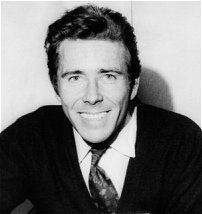 Tony Armstrong-Jones |
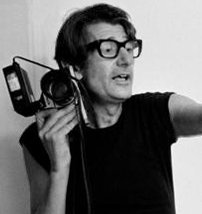 Helmut Newton |
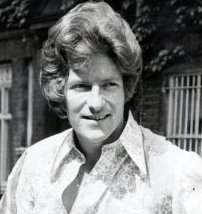 Patrick Lichfield |
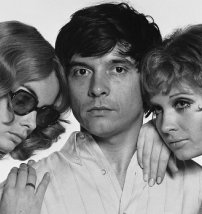 David Bailey |
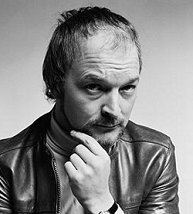 Brian Duffy |
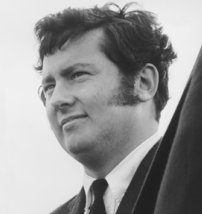 Terence Donovan |
 Sarah Moon |
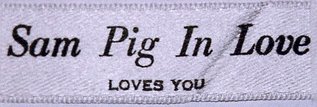 Norman Parkinson |
Probably the most famous, even notorious, of the Sixties photographers was David Bailey who started as a photographer with the Daily Express in 1959 working as an assistant to fashion photographer John French. He left to set up his own studio and managed to acquire a contract with Vogue which he used to turn Jean Shrimpton into one of, if not the, leading models of the Sixties. His fresh and irreverent approach to fashion photography launched his career and made him a leader of style in the emergent pop culture. His second marriage, in 1965, was to film star Catherine Deneuve, the best man being none other than a certain Mick Jagger. Bailey was the inspiration for the story behind the 1967 cult movie 'Blow-Up' starring David Hemmings. Other well-known snappers were Patrick Litchfield, a top fashion and celebrity photographer, famous for the ruffs, frills and velvet creations he wore, Tony Armstrong-Jones, a fashionable commercial photographer who became the Earl of Snowdon when he married Princess Margaret and Paris-based Helmut Newton whose op-art / pop-art fashion shoots graced the pages of Stern, Vogue and Queen magazine in the Spring of 1966.
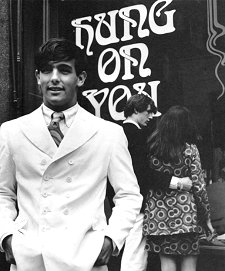 |
The
more fashion-conscious of youthful males dared to challenge the standard
'rules' of masculine dress that had hardly changed for half a century. One
of the resulting trends was the 'new romantic' dandy, flamboyantly attired
in frills, velvet, cravats and vividly printed shirts. Young entrepreneurs,
often from aristocratic backgrounds*, were not slow in taking advantage
of this remarkable change of style and, in the areas around Piccadilly Circus
that were already well known for dressing the British gentry, established
outlets whose brightly coloured products combined the more traditional tailoring
output with the design flair of the 'fashion graduate'. Many of these new
designers were a product of the newly-created 'menswear' courses run by
the Royal College of Art and London College of Fashion. 'Blades' was one of the first businesses to dare the sanctity of Savile Row tailoring. It was opened in 1963 by Charley Hornby and Rupert Lycett-Green. The company, with its slogan of 'For today rather than a memory of yesterday', boasted an impressive and varied list of clientele, including The Beatles. Michael Fish opened his Clifford Street tailors 'Mr Fish' in 1966, having previously established a reputation as the designer who brought traditional hosiers Turnbull & Asser more up to date with items such as fitted shirts and kipper ties. Tom Gilbey opened his design consultancy and fashion house in Sackville Street in 1968. The larger shops, although slower to react to the explosion in the youth fashion scene, also responded to the demands of the market. Harrods launched its Way In department in 1967 and other large, well-established shops, including Selfridges, also opened 'shop within a shop' boutiques that, although managing to appear to be intimate and informal, had the brand names, support and commercial advantages of a much bigger business. *Owning a boutique seemed to be the trendy thing to do among the aristocracy of the time. Socialites Janet Lyle and Maggie Keswick opened the Kensington boutique 'Annacat' in 1965. 'Hung On You', an elite Chelsea boutique, was owned by Michael Rainey, who was married to Lord Harlech's daughter, the hippy socialite Jane Ormsby Gore. Designer Antony Little produced window displays for both 'Hung On You' and 'BIBA', amongst others. It would take a very, very much larger article than this to even start to investigate the diversity and novelty of fashions of the Sixties in detail as fads were regional as well as national and international, and changed almost weekly, as immortalised in the words of the Kinks' 'Dedicated Follower of Fashion', but it is probably sufficient just to say that it was all NEW and, for a while, it was great fun! Also see: The V&A's 'An Introduction to 1960s Fashion' and the Sixties City page 'Fashions and Trends of 1963' |
|
|
All
Original Material Copyright SixtiesCity
Other individual owner copyrights may apply to Photographic Images |